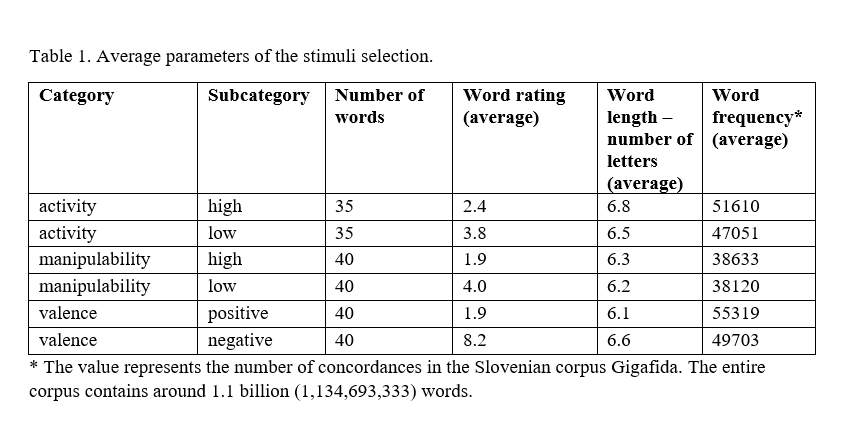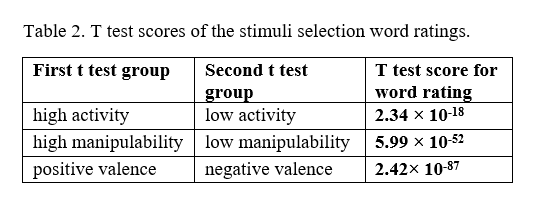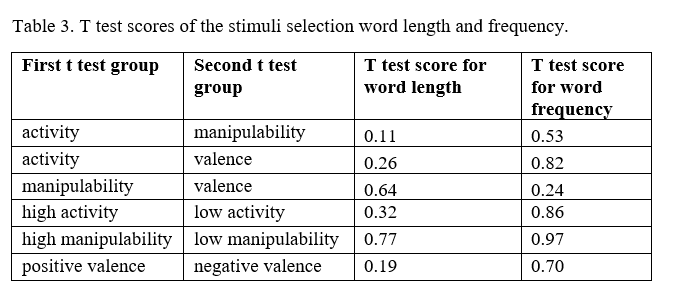Category: Parkinson's Disease: Cognitive functions
Objective: To prepare action-related (AR) and emotion-related (ER) linguistic stimuli in Slovenian language to test language functions in Parkinson’s disease (PD) patients.
Background: PD patients have difficulties in various language domains, including vocabulary (1). They have trouble processing AR and ER language such as action verbs, e.g., jump (2), nouns of manipulable objects, e.g., spoon (3) and emotional valence words with positive valence (PV), e.g., triumph, or negative valence (NV), e.g., gloom (4). Motor and limbic brain regions probably participate in processing AR and ER language (5, 6). PD causes dysfunction in these areas which may worsen processing of AR and ER words.
Method: To create the linguistic stimuli, we adapted action verbs from Druks et al to Slovenian language (7). Each verb was assigned into high activity (HA), e.g., run, or low activity (LA), e.g., sit category. We chose nouns from IMABASE (8) that we could clearly assign to high manipulability (HM), e.g., pencil, or low manipulability (LM), e.g., star, categories. We prepared 268 words, 75 in categories of HA and LA and 193 in categories of HM and LM. 120 native Slovenian participants assessed the level of activity or manipulability, scoring the words from 1 to 5 points, 1 being highest and 5 being lowest activity or manipulability. 40 PV and 40 NV words were selected from the Slovenian ANEW database (9). We identified the frequency of words using the Gigafida corpus (10). A lexical decision task (LDT) with the created stimuli will be used to test vocabulary dysfunction in PD[MT1] . In an LDT, the participants decide if a string of letters is a real word or not (11).
Results: We created a selection of the highest and lowest rated 230 words. Average rating, length and frequency for each category were computed (Table 1). A t-test was performed to determine that there are sufficient differences between average ratings in pairs of categories (Table 2). Average word length and frequency were tested between pairs of categories to confirm matching, which enables the comparison of semantic differences (Table 3). We expect to see more errors and longer response time in LDT for HA, HM, PV, and NV words compared LA or LM words.
Conclusion: Novel Slovene language stimuli were created for LDT, which should enable us to study word recognition for AR and ER language in PD patients.
References: 1. Smith KM, Caplan DN. Communication impairment in Parkinson’s disease: Impact of motor and cognitive symptoms on speech and language. Brain Lang. 2018; 185 (August): 38–46.
2. Auclair-Ouellet N, Hanganu A, Mazerolle EL, et al. Action fluency identifies different sex, age, global cognition, executive function and brain activation profile in non-demented patients with Parkinson’s disease. J Neurol. 2021; 268 (3): 1036–1049.
3. Bocanegra Y, García AM, Lopera F, et al. Unspeakable motion: Selective action-verb impairments in Parkinson’s disease patients without mild cognitive impairment. Brain Lang. 2017; 168 37–46.
4. Bell PT, Gilat M, Shine JM, McMahon KL, Lewis SJG, Copland DA. Neural correlates of emotional valence processing in Parkinson’s disease: dysfunction in the subcortex. Brain Imaging Behav. 2019; 13 (1): 189–199.
5. Temel Y, Blokland A, Steinbusch HWM, Visser-Vandewalle V. The functional role of the subthalamic nucleus in cognitive and limbic circuits. Prog Neurobiol. 2005; 76 (6): 393–413.
6. Klostermann F, Wyrobnik M, Boll M, Ehlen F, Tiedt HO. Tracing embodied word production in persons with Parkinson’s disease in distinct motor conditions. Sci Rep. 2022; 12 (1): 1–11.
7. Druks J, Masterson J. An Object and Action Naming Battery [Database record]. J Neurolinguistics. Published online 1998.
8. Bonin P, Poulin-Charronnat B, Lukowski Duplessy H, et al. IMABASE: A new set of 313 colourised line drawings standardised in French for name agreement, image agreement, conceptual familiarity, age-of-acquisition, and imageability. Q J Exp Psychol. 2020; 73 (11): 1862–1878.
9. Marjanovič K, Manouilidou C (in prep.). The adaptation of the Affective Norms for English Words (ANEW) for Slovenian.
10. Gigafida 2.0: Korpus pisne standardne slovenščine, viri.cjvt.si/gigafida
11. McDonald C, Brown GG, Gorell JM. Impaired set-shifting in Parkinson’s disease: New evidence from a lexical decision task. J Clin Exp Neuropsychol. 1996; 18 (6): 793–809.
To cite this abstract in AMA style:
ž. Drakulić Gorše, C. Manouilidou, M. Trošt. Action- and emotion-related language abilities in Slovenian-speaking individuals with Parkinson’s disease – a background normative study [abstract]. Mov Disord. 2023; 38 (suppl 1). https://www.mdsabstracts.org/abstract/action-and-emotion-related-language-abilities-in-slovenian-speaking-individuals-with-parkinsons-disease-a-background-normative-study/. Accessed December 31, 2025.« Back to 2023 International Congress
MDS Abstracts - https://www.mdsabstracts.org/abstract/action-and-emotion-related-language-abilities-in-slovenian-speaking-individuals-with-parkinsons-disease-a-background-normative-study/



